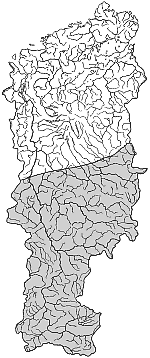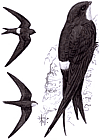|
|
| Main |
| Systematic List |
| Photo |
| Central Siberia |
| Guest book |
| Awards |
| SEARCH |
|---|
|
|
Apodidae |
|---|
Pacific Swift Apus pacificus (Latham, 1801)
|
 A characteristic East Asian species closely associated with rocks and rock faces, the Pacific Swift is generally more numerous than the Swift. It occurs mainly in the southern part of Central Siberia up to the Angara River area (Ptushenko 1951) and along the middle reaches of the Nizhnyaya Tunguska River north to 64° N (Tkachenko 1937). In taiga, it occurs only along the mountainous eastern bank of the Yenisey. It is most likely this swift that was once observed on the Yenisey in northern taiga near the village of Vereshchagino (Tugarinov and Buturlin 1911). B.N. Andreev lists this species as a common breeder on the rocky cliffs of the Viluy River and its tributaries on the upper reaches of the Viluy River system (Andreev 1974). A. A. Vakhrushev found this swift in watershed larch forests in northern taiga, 40 km north of Tura in 1978 (Vakhrushev and Vakhrusheva 1987). In Yenisey mid taiga, the species was also noted on several occasions at Mirnoye, Verkhne-Imbatskoye, Alinskoye, and on the lower reaches of the Yeloguy River. On June 13-15, 1977, the species was seen near Alinskoye, 63° 15' N, in the north of the mid taiga subzone (Rogacheva et al. 1978). It is not observed every year at Mimoye: 1-2 pairs are seen along the Yenisey during spring migration (May 29-June 1, 1981, and on June 3, 1978) or during the breeding season (June 21, 1984, and June 24, 1980). Three birds seen circling over the taiga within 2 km of Mirnoye on July 2, 1984, and two other birds noted at the mouth of the Malaya Varlamovka River on June 30, 1984, did not seem to be breeding. Nesting in the area is most likely at the pillar-like rocks at the mouth of the Stolbovaya River where three pairs were observed in mid June in 1982. Nesting is also possible in other rocky massifs in the eastern part of the Central Siberian Reserve in western Evenkia. According to N. I. Petunkin, a biologist, the Pacific Swift nested on a triangulation tower on the lower reaches of the Yeloguy River. In 1958, the species was recorded as a common breeder throughout the Podkamennaya Tunguska River valley from the Oron rapids on the upper reaches down to the mouth. The birds were found nesting in colonies on large rock faces lining the river, particularly between the Oron rapids and Vanavara (Syroechkovski 1959). We observed large breeding colonies of 50-100 pairs on the Angara River near Motygino and along the Kamenka River, a tributary of the Angara. O.V. Bursky and A.A. Vakhrushev reported the species along the Yenisey near Fomka (Bursky and Vakhrushev 1983), and it was also seen near Vorogovo (Rogacheva et al. 1978). In the south, near Krasnoyarsk and upstream along the Yenisey, the Pacific Swift is a common breeding bird wherever there are suitable rocks; near Krasnoyarsk itself and in its vicinity, it is much more numerous than the Swift (Yudin 1952). It also occurs locally in taiga of flat landscapes such as along the Bolshoy and Maly Kemchug Rivers where it nests in hollows of dry larches. Nearly all the observed colonies occur near large bodies of water. |
[Back] |
|
|
|
|
Сайт разработан и поддерживается кафедрой прикладной экологии и ресурсоведения СФУ
